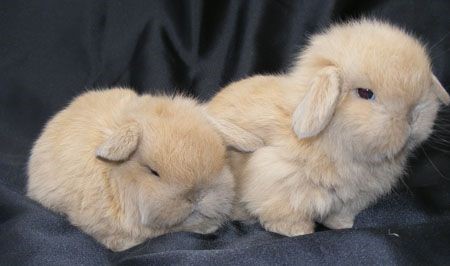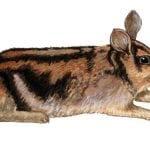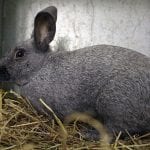Scientific Facts
| Common Name | Sussex Rabbit |
| Scientific Name | Not indicated |
| Life Span | 6 to 8 years |
| Size (Adult) | Medium |
| Weight (Adult) | 7 lbs. |
| Body Shape | Compact |
| Habitat | Wildlife |
| Country of Origin | Europe, UK, and England |
Physical Description

Such a rabbit that possesses teddy-bear features, the Sussex Rabbit is lovable due to its personality. It is a popular breed for its gold color, but more often, it is reddish gold featuring milk chocolate shading. It also can be found in cream or pinky cream colored with a lilac shading.
This medium to huge-sized bunny is big enough, but it makes a perfect companion to other pets like dogs and cats. It is indeed a great house rabbit that loves interacting with humans.
Love how attractive this rabbit can be. Notice as well its body-shape that is well-rounded. Its head is short while its legs are short, too. Its ears are held upright, leaving you like it more.
Fast Facts
Here are some of the fast facts about the Sussex Rabbit:
Best Suited for: Families having children and pets around and rabbit owners of any experience level
Temperament: Friendly, Affectionate, Loving, Outgoing, Mischievous, and Docile
Comparable Breeds: Lilac Rabbit and Californian Rabbit
Colors

This breed features 2 colors of gold color and red-gold color. As per the gold one, it is as mentioned as the teddy bear color. The red-gold one also highlights chocolate brown shading. Another color is the cream that is lighter as it features pink-cream or lilac shading.
Lifestyle and Behavior
While some rabbit breeds can be quite difficult to befriend, that is not true when it comes to the Sussex Rabbit. This is a gorgeous and friendly rabbit that makes a perfect pet for you. It is docile, friendly, and inquisitive. It is also very intelligent that makes it easy for you to teach it with breed tricks.
Since this can become greedy as a pet, it can also get fat quickly. That is when you need to monitor its weight. Control the treats you feed your bun, or else it might get rounder and rounder as months go by.
It is recommended to keep the Sussex Rabbit inside a comfortable cage. The outdoor cage should also be made of weatherproof materials. Whatever you choose, be it a hutch, crate, or cage, it should relax in it and move freely.
Habitat

When you go for Sussex rabbit as a pet, make it sure of its housing or habitat. Do not just keep it outside as it will only put it at risk of loneliness and premature death. It is prone to hypothermia, overheating, and attacks by the predators.
Choose from a wide range of hutches and indoor cages for Sussex rabbit. House it inside a room that will keep it safe. Keep it as well in a puppy playpen or a rabbit condo. In whatever it is that you choose, the Sussex rabbit should have enough space to move around.
The indoor hutch should have a minimum length of 4-feet. 5-feet will be a lot better in this regard. Its width should fall at exactly about 2-feet while the enclosure must be high enough for it to stand up on its hind legs. But without the ears that touch the top.
Do not choose a wire bottom cage as it might only get the rabbit’s feet hurt. Buy a cage that comes with a solid metal bottom material. Or, cover the underneath of the cage with plywood.
Make sure that the floor of the cage is covered with 2 to 3 inches of bedding. Add some more numerous substances for the bedding like the paper pulp, straw, and shredded cardboard.
Give it a hiding place for it to feel more secure as it can best retreat when it feels stressed. Place some wooden box or cardboard box and cut a hole out of into the cage.
Social Habits
The Sussex Rabbit is known for being friendly, inquisitive, and affectionate. It has also been described to be the same as the Labrador for its behavior and temperament. It is easy to please while being playful. Its mischievousness and confidence make it more of a social creature. This is especially true as it is calm and docile. This is what makes it a popular pet for children. Make a decision to get this rabbit for your child today.
Eating Habits
Give the Sussex Rabbit a diet with gnawing toys and fibrous veggies. These will be enough for its teeth not to grow more. Add some more hay that is the best food type for it. Hay can provide the essential nutrition needed by the rabbit. Better to check on its hay supply to make sure that it is enough. For one, Timothy Hay makes an excellent type of hay to give the rabbit.
Offer the Sussex rabbit too, with a plain rabbit kibble. This will give it enough nutrition but make it sure it be in a small amount. Limit its kibble intake to about one-fourth cup every day.
For an overweight rabbit, it may need only less amount of kibble. Check with the vet for the best recommendation of kibble. Give it some more fruits and vegetables. Carrots, dark leafy greens, and fruits will be healthy choices for the rabbit. Give your pet dark leafy greens, apple slices, carrot slices, and many more. Other healthy fruit and veggie treats for your pet can include parsley, basil, cilantro, collard greens, banana slices, apple slices, carrot slices, and kale.
Other than the foods, also keep it up hydrated, too. It will need constant access to clean and freshwater. Better to provide for a sipper bottle that will work well so that it will not spill as a watering can. With a sipper bottle, it will not likely get contaminated with feces or hay.
Keep the water bottle full of clean water all the time. Better to use a water dish and a ceramic bowl. Check the water there more often.
Only feed the Sussex rabbit with certain foods in moderation. If it eats up in huge amounts, it may give the rabbit bloat, gas, and diarrhea. Let it eat foods of broccoli, cauliflower, cabbage, spinach, and Brussels sprouts.
Grooming
Brush the Sussex rabbit once every week. This will need to be done to keep its fur soft. This will also help reduce shedding. Make use of a fine-toothed comb or a natural bristle brush to go over the rabbit’s fur once every week. Do not bathe it, or else it may become hypothermic. That is true when it gets wet. It does not like it getting wet either.
Spaying or Neutering
Get the Sussex rabbit neutered or sprayed. Since you have no plan of breeding the Sussex rabbit, better to get it spayed or neutered. By spaying and neutering the rabbit, it helps prevent the onset of any unwanted litters. This will as well protect the health of the rabbit.
Keep in mind that when this breed is not spayed or neutered, it might become exposed to some hormonal behaviors. These can include the behaviors of urine spraying or fighting. If your Sussex rabbit is not spayed on, it will only put it at a higher risk of uterine cancer.
Temperament and Personality
Before you get this rabbit from a pet store, you need to think about its personality. Bear in mind that it has been dubbed as the Labrador of the rabbit world. It is very eager to please, as it shows playfulness, inquisitiveness, and friendliness. What more to know about it is that it loves to eat food.
Truly this rabbit is one of the best breeds for families having children. This is also ideal for the families and individuals having lots of time interacting with its pet. This animal enjoys much of the attention given by the owner.
One more thing about the Sussex rabbit is that it is easy to train by the owners. Teach it the way to perform tricks, and it will gladly do so. It is very much intelligent without you being disappointed. This rabbit can also learn how to best use the litter box.
Lifespan and Health Concerns
You may be enamored with keeping the Sussex rabbit as a pet. But you need to make sure that the pet is taken care of. All necessities must be provided like exercise, drink, food, and more. The lifespan of this breed is 6 to 8 years. Its life span will still depend on the availability of foods, diseases, predators, and the way it survives in a given environment.
Bear in mind that a domestic Sussex rabbit’s life span will be a lot longer than the one kept in the wild. This is due to favorable environmental conditions as one obvious factor. No predators should be there around its cage. And there must be less competition for food. Special attention must be offered once when it gets sick.
Prior to the main health concern of the Sussex rabbit, only one thing will keep you worried about- weight gain. Monitor weight at all times. Make sure that it does not gain much of its weight. This is because the breed can become quite greedy as to food. If it becomes overweight, it can become difficult for it to groom itself. It will then become exposed to flystrike as it spends most of its time outside.
Since its head is compact, it is more likely to suffer from eye ailments and mouth problems. Face the fact that it is more prone to dental problems. You better give it lots of gnawing toys and fibrous veggies to avoid overgrown teeth.
Health Care
It will be necessary to keep the Sussex rabbit healthy by exposing it to regular exercise. Make sure that it gets 2 hours or more of exercise each day. Allow it to get out of its cage for an exercise.
Keep it indoors so that it won’t be exposed to danger from predators. Confine it to 1 or 2 rooms. Keep it in the bedroom or place a couple of baby gates. Doing so makes sure that it stays in the area of your house.
Hide some electrical cords using a spiral wrap or hard plastic tubing. Keep all of the cords off of the ground. This is also while the rabbit is out of the cage. Prevent it further from chewing on those things it should not. It will tend to chew on door edges, chairs, table legs, and wall trim.
When you notice it chewing on something, do not punish it or get mad at it. Pick it up and move it away from the object. Provide it with something that can get its attention away from it. This can include a raw carrot or a cardboard box.
Also, take the Sussex rabbit to a vet clinic. Keep it healthy as possible by taking it for annual check-ups. Monitor the health of the rabbit. If it seems ill at all times, take it to see a vet. Among other signs that the Sussex rabbit can be ill include loss of furs, loose stools, not hopping or not using back legs, not producing urine or producing dark reddish urine, not reacting normally or not moving, having a runny nose or runny eyes, drooling or wet chin, having a fever of 105-degrees Fahrenheit.
Special Care Considerations
Talk to the vet about having the Sussex rabbit vaccinated against the Myxomatosis and viral hemorrhagic disease. Check the rabbit for possible infestation of fleas, worms, and ticks. This is also when it spends more time in the outdoors.
Breeding
There only is simple information about the breeding of Sussex rabbit. And that the bred rabbit will need to consider following a diet that complies with the recommended guidelines. There also must be some form of enrichment to follow.
Special Notes
Prevent the rabbit from defecating and urinating all over the cage. Place some small-sized litter box in the corner of the cage of the rabbit. Place some sheets of newspaper into the litter box. Layer the hay right above the newspaper. Clean the litter box to avoid the cage from smelling.
Move the litter box of the rabbit to one corner. Move it through the corner that it uses to defecate and urinate. Place a couple of litter boxes so that it can use it. Also, be aware of the pellets that the rabbit tends to pass. The one type is the cecotrophy that still contains food partially digested. But still, this contains nutrition. The rabbit will still eat this up again. So you better not remove it from the cage or the litter box.
Breeders National Federation
If you plan of owning and breeding Sussex Rabbit, the American Rabbit Breeders Association is a reputed organization that promotes, develops, and improves the domestic rabbits that include the Sussex Rabbit. It boasts 23,000 members all over the United States and abroad. From the pet owners to the breeders to the commercial raisers, there are a lot of rabbits raised by the organization. Each aspect of the rabbit is encouraged by the organization.
Since you have no idea of breeding a rabbit as such, the ARBA is the best place for you. You will discover a lot of benefits from joining the ARBA, including the guidebooks and magazines to guide you all throughout.
Cost
No specific cost is documented yet particular to buying the Sussex rabbit. But just the same as other rabbits, the pet rabbit must be prepared with the initial and ongoing costs. This is part of responsible rabbit ownership.
Know that it will require an amount of money, time, and care. But here is a quick rundown to the initial costs of having a pet rabbit. The adoption fee might fall down to 70-dollars, the puppy pen amounts to 70-dollars, the litter box costs 5-dollars to 10-dollars. The hay feeder amounts to 50-dollars to 100-dollars, the small flashlight and the nail clippers fall down to 25-dollars, the cord protectors also cost 35-dollars, and the chair mats fall down to 70-dollars.
Since the Sussex rabbit will live up to about 6 to 8 years, the litter will cost 18-dollars every month, the hay will cost 20-dollars every month, the vegetables and greens will cost 40-dollars every month, the pellets will cost 5-dollars every month, and the pet- safe cleaning supplies cost 2-dollars every month.
Be prepared as well of the incidental costs that include the vet bills, bunny supply replacement, furniture, and other replacement and repair possession, and store-bought tunnels and toys.
Consider bargain shopping, careful planning, time, and DIY time as much as possible. Ensure that you have enough budget to cover the incidental costs. This is particularly true to the vet bills. These are so far non-negotiable that they are deemed essential to the well-being of the Sussex rabbit.
Availability – Where to Get One
Check the nearest pet store in your local area. The goal is to see if there is an available Sussex Rabbit. There already are online websites and stores that can be found. They will also ship the rabbit right through your door. Better to contact the reputed breeders as they may be selling Sussex Rabbit, too.
FAQs
What does the Sussex Rabbit eat?
The Sussex Rabbit is an herbivore animal. That is why you should feed it with a varied diet of a range of rabbit pellets, vegetables, fruits, and high-quality hays. Be sure to provide it with a source of fresh and clean water.
How much food do I need to give my Sussex rabbit?
Give only a small amount of food like a kibble each day. Limit its kibble intake to about one-fourth cup every day. If ever it is overweight, it may just need a little amount of kibble.
Can Sussex Rabbit eat broccoli and oranges?
Just like the veggies, broccoli and oranges are safe for the Sussex rabbit to consume. The same is true when it comes to broccoli. But these must not make up the entire diet of the Sussex rabbit.
Does the Sussex Rabbit bite hurt?
The foods that can be toxic for the Sussex Rabbit are rice, bread, potatoes, lollies, biscuits, chocolate, avocado, and chips.
Does the Sussex Rabbit scream?
Yes. The Sussex rabbit screams as a sign of fear or pain. It will scream if it gets stressed, scared, or frightened.
Why do you need to find an exotics veterinarian?
You need to find one as it is knowledgeable and expert in the caring of the rabbit.
Does the Sussex Rabbit need exposure to the sun?
Ues. The rabbit needs some exposure to the ultraviolet lights of the sun to build its strong bones. Take it outside and train it harder as you want to.
Is the Sussex Rabbit easy to train?
Yes. It can be so much easier to train this breed than any other breeds of rabbit. This can be taught any tricks as it is intelligent not to disappoint you.
Can it live comfortably with other pets?
With its small size, it can live comfortably with other pets like cats and dogs. This is also for as long as it gets along.
Is the rabbit just good to be kept as a companion animal?
No. Sussex rabbit is not just as good as a companion animal as it also excels as a show rabbit.

